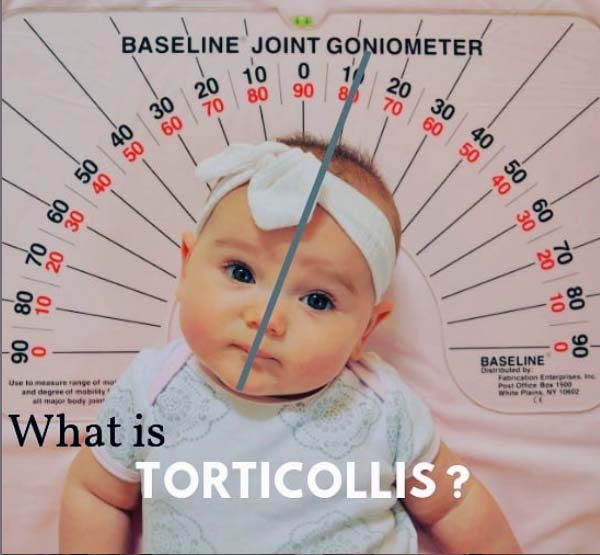
What is Torticollis?
Torticollis is a condition that affects the neck muscles, causing the head to tilt to one side or downwards. This condition can be something that a baby may be born with, and it is called congenital torticollis. In some cases, the baby can also develop this condition after birth and this is known as acquired torticollis.
Causes of Torticollis in Babies
1. Tightness of the muscle
Congenital torticollis could be caused due to stress or tightness caused to the muscle connecting the breastbone and collar bone to the skull. This muscle is known as sternocleidomastoid muscle. This tightness is usually caused due to an unusual positioning of the baby’s head during the gestation period.
2. Irregularities with the spine
Though this is less common, there are certain conditions of the spine such as Klippel-Feil syndrome that can cause torticollis. In this condition, the vertebrae of the neck will either be abnormally formed or fused or both.
3. Genetics
In extremely rare cases, the muscles or nervous systems will be affected due to serious medical conditions that are hereditary.
Symptoms
There are many signs you can keep a lookout for to ensure your baby’s muscular development is normal. However, you must remember that these signs will manifest only after four or six weeks of birth.
- You will notice that your baby’s head will tilt to one side with the chin pointed in the opposite direction. In most cases, the head will tilt towards the right side.
- Mobility of the neck is restricted.
- In some cases, you can also feel a lump on your baby’s neck.
- Notice how your baby looks at people. In most cases of torticollis, your baby will not follow someone as that would involve moving the neck.
- Your baby will prefer being breastfed only on one side and will have difficulty with the other.
- You will also notice that your baby has to put in more effort in order to look at you.
- Since neck movements are difficult, your baby might develop a flat head due to laying down with the head in a single position.
Diagnosis of Torticollis in Infants
If you suspect that your baby is unable to move his neck, then you must immediately consult your baby’s doctor. She will conduct a physical exam in order to check the mobility of your baby’s neck. She might also ask for an x-ray in order to diagnose the exact type of torticollis your child has. Based on this, she might ask for ultrasounds of the pelvis and kidneys.
Home Remedies for Torticollis in Babies
Apart from the bending and stretching exercises taught by the physiotherapist, there are a number of other ways to get your baby to relax and use the tight muscles in the neck.
- When feeding, offer the breast or the bottle in a manner where your baby will turn towards that side he doesn’t usually prefer. Since the impulse to satisfy his hunger will be strong, he will have sufficient incentive to stretch the tight muscles.
- When stimulating your child with toys and lights, make sure that you do so from both sides so that your baby gets adequate exercise on both sides of his neck.
- Do not try to force your baby to spend time on his stomach. Place your baby on his stomach on a soft blanket on the floor, especially during playtime. This will get your baby to lift his head and increase the strength of the muscles in his neck.
- When babies are laid down to sleep, they like to look at the entire room. If your baby has torticollis, then place your baby such that the side he prefers faces the wall. This will give him enough inducement to turn in order to be able to see the room.
How Long Does it Take to Recover or See the Results?
Recovery from torticollis in babies is highly dependent on when the condition is diagnosed and how well the physiotherapy is done. Ideally, your doctor should identify issues with torticollis around the age of two or three months. Then it is simply a matter of how diligent you are with the exercises given to you by the physiotherapist. If these criteria are met, then you should see a significant improvement within a few weeks. In most cases, the condition will correct itself by the time your baby turns one year old.
When to Consult a Pediatrician
Since torticollis requires early intervention for a full recovery, it is best that you consult with your baby’s doctor as soon as you notice any signs of torticollis mentioned above. Be sure to keep all your child’s doctor’s appointments and ask that a proper physical examination of your baby’s neck is done.ADVERTISEMENT
Severe torticollis in infants is a highly treatable condition but timely intervention and commitment to recovery are essential. Be sure to discuss any doubts you might have with the doctor.




0 Comments